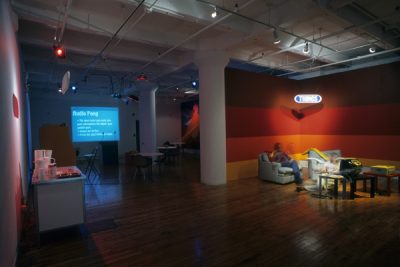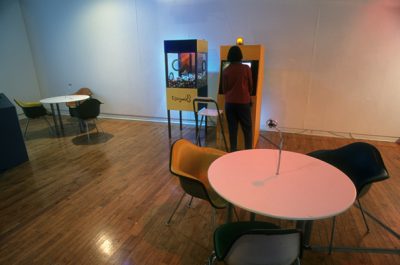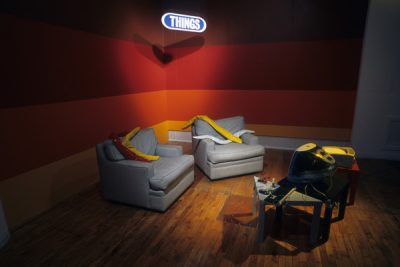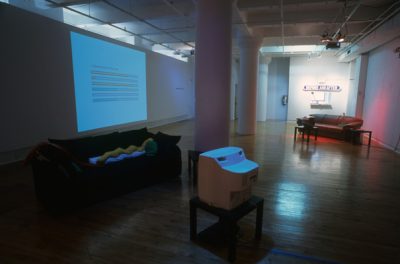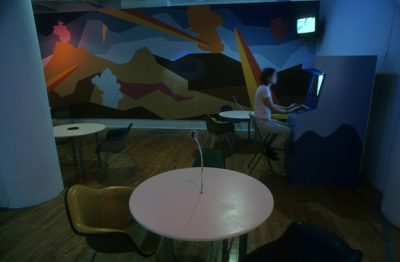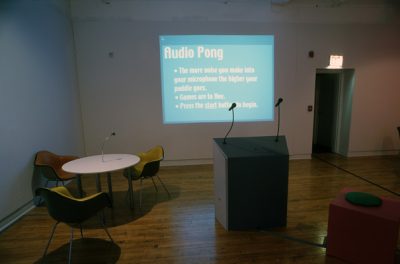Exhibitions
ABOUT THE EXHIBITION
For The Electric Donut, Kristin Lucas and Joe McKay transform Gallery 400 into a café with video games, surveillance equipment, and a mural. The original Electric Donut was the first video arcade to open its doors in Kristin Lucas ’s small Iowa hometown, and there she spent many adolescent hours mastering the once wildly popular games Pac-Man and Donkey Kong. For this collaborative project, Lucas and Joe McKay bring the Electric Donut back to life by reconfiguring the lounge into a café and video arcade. This seemingly innocuous public space of entertainment and relaxation is converted by the artists into a site that not only plays with our nostalgia for childhood games, but also brings to light the ways in which the growing prevalence of technology has instigated feelings of isolation and disembodiment as well as a sense of being watched and controlled.
This seemingly innocuous public space of entertainment and relaxation is converted by the artists into a site that not only plays with our nostalgia for childhood games, but also brings to light the ways in which the growing prevalence of technology has instigated feelings of isolation and disembodiment as well as a sense of being watched and controlled.
Visitors to The Electric Donut can help themselves to coffee and relax or play with any number of games developed by Lucas and McKay. The artists ’ computer-generated games borrow the visual language of video games that are a mainstay of popular culture—brightly lit bands of color, animated explosions, and flying spacecraft are found, for example, in Audio Pong, Summer in New York, BLAM! and Electromagnegligence—but surveillance cameras mounted on the café tables simultaneously create a space of anxiety and potential hazard. Live footage from these cameras are screened on monitors in the gallery, while text messages entered by visitors playing BLAM! pop up on the screen of Electromagnegligence, creating the possibility for surreptitious communication between visitors. This takes participation with the works in The Electric Donut beyond playful interactivity into the realm of complicity in being watched.
In the Surveillance Café, visitors to BLAM! and Electromagnegligence are submitted as images and voices into the action around them. In Electromagnegligence, hitting key icons (the video camera was one of three of these secret icons) with electro-waves triggers images to be sent onto the BLAM! screen. Texts submitted to BLAM! can be sent back as responses. The cameras sprouting from the Surveillance Café ’s tables continuously send images to a monitor hanging where all can see.
Also located in the gallery is Simulcast Vending Machine, which offers free Simulcast take-home kits. These plastic balls are filled with simple, elementary school art class-like objects presented as tools “for lifestyle enhancement,” which promise to moderate the flow of numerous energies stimulated by technologies currently vying for space in our atmosphere. These objects, created without the assistance of digital technology, offer an alternative to slick and overly designed, digitally produced works. Playing the role of providing that which we in the information age don ’t yet know we need, Lucas distributed the Simulcast take-home kits in cities from Tokyo to Linz and spread her Simulcast message broadly via the website www.simulsite.com. Though a bit tongue-in-cheek and unquestionably playful, Lucas and McKay ’s The Electric Donut addresses the ubiquity of technology in our lives and seriously asks us to contemplate whether “progress” is always worth the threat it poses when considering the environment and individual well-being.
In McKay ’s Progress Clocks, the bars that visitors scroll across give them the current U.S. Central Time as measured from a zero point for each measure of days, months, seconds, etc. The bars recall computer program task bars that fill up with color until the moment the task is done. As visitors move the mouse over the bars, they realize that McKay ’s computer is clocking up the time, although the bars have no connection to how the computer calculates time.
Describing similar effects in her work Lucas said, “Because of the integration of computers into our lifestyles, we are more likely than ever to be following paths that have been predetermined for us. Turn on computer, use pull down menu, double click on icon…” In Lucas ’s work, interfaces between humans and machines are layered into videos, such as Watch Out for Invisible Ghosts (1996), or built into the structure of the games BLAM! (2001) and Electromagnegligence (2001). In Watch Out for Invisible Ghosts, Lucas portrays both a player and a character. Shifting between a player operating the joystick and a figure in action, Lucas ’s image is literally layered into games such as Pac-Man and Defender. But more than physically occupying the game, Lucas is emotionally tied in as well. Shifting between player and character guises, she expresses elation, anxiety, and sadness as the game action progresses. The game lives both on the screen and in her head.
Playing and played, pictured and quoted, controlling and controlled, visitors are absorbed into the realm of The Electric Donut. It was Robert Smithson who said in the early days of video art, “I ’m interested in the apparatus I ’m being threaded through.” The Electric Donut makes clear that we are more than threaded through technological apparatuses. Hooked into, interfaced with, pre-programmed by, networked within, and even automated by technology, we are interpenetrated by its proliferation around us.
ARTISTS
Kristin Lucas and Joe Mckay
SUPPORT
The Electric Donut is supported by the College of Architecture and the Arts, University of Illinois at Chicago, and a grant from the Illinois Arts Council, a state agency.


